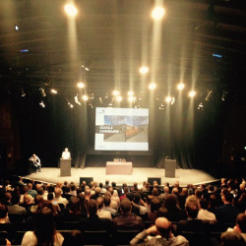Kirsty Weakley rounds up the learning from the Charity Technology Conference, and finds it was less about new gadgets or apps, and more about the people whose lives they change.
Our technology conference covers a lot of ground – from the latest in customer-relationship management software approaches, to building leadership skills, dealing with a security breach, or using the latest social media to engage with future donors. But there was one word that came up in almost every session: “People”.
The key message from the conference was that successful use of technology was not dependent on programming expertise or technical knowledge, but understanding the people who would interact with it, whether staff or service users.
The conference heard this is true whether you are designing a new service, improving an existing one and ‘putting the beneficiary at the heart of it’, working with IT users in other departments to understand what they need or help them use new technology, or engaging better with stakeholders. Success is down to others believing in what you want to do. For technology to lead an organisation, you have to take the people with you.
So with that in mind, what did we learn?
You have to trust others with your technology
It might be difficult and they might not always do it quite as you’d envisaged. But when charities have empowered their staff and volunteers to use social media or other tools, it pays dividends.
Luke Williams, social media innovation officer at RNLI, told the conference he was often asked whether the charity could trust volunteers on social media. He said his answer is “well, we trust them with a lifeboat”.
He also said that he has used the words of the RNLI’s founder, Sir William Hillary, “with courage nothing is impossible” to convince people to try something new. And RNLI really is leading the way in some areas – this year it developed an education tool using the online game Minecraft and has an active Snapchat and Instagram following.
Zennon Hannick, chief technology officer at Comic Relief stressed that the public now have different expectations and it was important to “let go” and “see what people want to do to engage with us”.
Everyone is talking about digital transformation
The phrase may be in danger of becoming jargonistic, but it really was what everyone was talking about.
And there is a good reason for that. Digital transformation doesn’t just mean setting up a new website or Twitter account – it’s deconstructing what the charity does and how it does it, and whether new tools offer the opportunity to do it it better. It can often be quite disruptive. This means it presents opportunities and challenges for the IT and digital teams alike, as well as for the rest of the workforce.
Rosie Slater, chief information officer at the British Red Cross, described digital transformation as being about going “one step further than" and said it was important to “spend time understanding what people need from us and how it can be radically different”.
Data has never been more important
Evidence is a big thing for charities at the moment, with funding increasingly hard to come by and the sector as a whole under greater scrutiny. While technology can often provide a solution, it’s also more important than ever to build a case for investing in new technology.
That’s not to say it shouldn’t be done, but as Bob Darby, director of information services at Barnardo’s told delegates, it was important to “articulate the value of IT” and demonstrate that you understand the “business we’re in”.
Good communication can be a game changer
Communicating well, both internally and externally, makes a real difference to how you and your charity are perceived.
Maria Turnbull-Kemp, finance and operations at the British Judo Association, explained how her charity responded to a massive security breach, which saw its members' personal details end up in the hands of hackers.
Members of the senior management team personally started taking the phone calls coming in from concerned members.
She said it was important that they were “sympathetic” to concerned members, not just repeating the press statement, and the “way we communicated that message made a massive difference” and also showed how seriously the organisation took the breach.
There is no end in sight
But that might not be a bad thing. A delegate in the CRM panel debate asked how to avoid constantly having to go through the process of updating or replacing their systems, only to be told that it probably wasn’t possible.
“We are always in the business of revising and thinking imaginatively where we need to go next,” Simon Capper head of perfomance and insight at WaterAid.
This chimed with what Zennon Hannick was saying about the thinking about technology products rather than projects to switch the focus onto “long-running improvement”.
Personally I’m glad that there’s no end in sight – it would be pretty dull as a charity technology journalist if there was.









